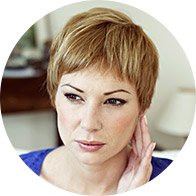Noise-induced hearing loss

What is noise-induced hearing loss?
Noise-induced hearing loss occurs when hair cells in the hearing organ (the cochlea) are damaged by exposure to higher than normal levels of noise.
Typically, noise-induced hearing loss occurs in both ears and is characterized by not being able to hear noises between 3,000 and 6,000 Hertz (hz). It is the second most common cause of hearing loss, after age-related hearing loss (presbycusis).


Book a complimentary assessment for noise-induced hearing loss
What causes noise-induced hearing loss?
Excessive long-term exposure to louder than normal sounds (typically sounds over 70 dB) is the main cause of noise-induced hearing loss.
The extent of the damage and the speed of the onset is dependent on a number of factors, including:
- Length of exposure
- Sound level and proximity
- Level of hearing protection being worn (if any)
Noise-induced hearing loss is caused by either recreational (loud music, concerts, headphone use etc.) or occupational (working in a factory, industrial sound, working on a construction site without hearing protection) noise.
4 common signs of noise-induced hearing loss
The main symptoms of noise-induced hearing loss often go away after the exposure to the noise ends. If the noise exposure is repeated and more cells are destroyed, then you can develop lasting hearing loss. The symptoms are seldom painful, so they can be hard to identify.
How to prevent noise-induced hearing loss?
Noise-induced hearing loss can be prevented by using hearing protection. Hearing protection is widely available online and in stores and comes in many varieties. The cost of the protective gear largely determines the level of protection it provides. This type of hearing wear protects the ear from nerve damage by dampening the noise level.
How to prevent hearing loss
The types of hearing protection available on the market include the following:
- Foam ear plugs - Foam ear plugs are the cheapest form of hearing protection available on the market and are most commonly used by those in the construction industry.
- Rubber plugs - These are similar to the foam plugs, but they have a more rigid construction, meaning they may not be suitable for all ear canal shapes.
- Banded ear muffs - This form of hearing protection is made up of ear muffs connected by a headband. They look similar to noise-canceling headphones and are commonly used for loud recreational sounds.
- Custom ear molds - Custom ear molds are generally made from a silicone material, and they are personalized to fit the exact shape of the user's ear.

Treatment for noise-induced hearing loss
In most cases, noise-induced hearing loss can be treated with hearing aids. While the hearing impairment itself cannot be cured, hearing aids are effective in significantly improving your ability to hear the sounds and conversations around you.
In addition to wearing hearing aids, avoiding exposure to excessively loud noises can also prevent your hearing loss from getting worse.








